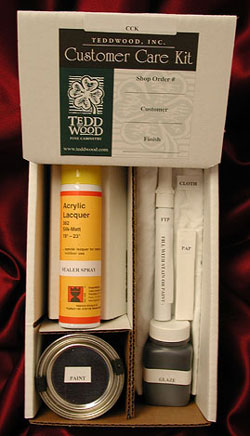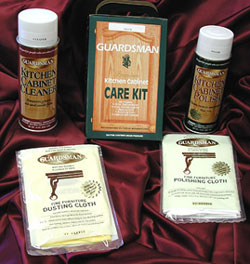Handcrafted from quality woods and materials, our beautiful Tedd Wood cabinetry is guaranteed to meet your high standards and give you a lifetime of pleasure. Properly cared for, well-finished Tedd Wood cabinetry will stand up to most common spills and will become richer and more beautiful as the years go by.
CLEANING
Tedd Wood recommends using a cleaner that contains a degreasing agent as well as a cleaning agent to bring the beauty of the finish and cabinetry to its peak. Washing the cabinetry with soap and water should be avoided, as this may leave a film and can harm the finish if left on the surface too long. Always immediately and thoroughly dry any cabinet surface exposed to water or moisture. Do not use a cleaner or polish that contains silicone, as this will limit any repairs that may ever need to be made to the cabinetry. (For example, if you scratch your cabinetry after applying a product that contains silicone and then try to use a touch-up kit to repair the scratch, the aerosol top coat will repel and create a “fish-eye” appearance.)
Always check the label on the bottle or can to verify that no silicone exists in the product. There are several good cleaners and polishes on the market that do not contain silicone, and these products should do a good job when used properly. Tedd Wood does recommend one product that is manufactured by Guardsman, which is designed with a unique formula for fine furniture/cabinetry. Used as directed, Guardsman Cabinet Cleaner will safely emulsify and lift old polish and wax, as well as many types of stains and discolorations. All Tedd Wood authorized dealers carry a Premium Kitchen Cabinet Care Kit (PKCCK), which contains the recommended Guardsman cleaner and polish.
DUSTING
Like fine furniture, wood cabinets should be dusted periodically. Always dust your cabinetry with a polish-moistened cloth. However, do not over-moisten the cloth. Using a cloth moistened from a faucet is not recommended by Tedd Wood, as excessive water or moisture on the cabinetry may cause a finish failure. Again, always be sure to immediately and thoroughly dry any cabinet surface exposed to water or moisture. Avoid dry dusting, as this may scratch the surface. It is a good practice to follow the grain of the wood while dusting, because wiping against the grain may cause scratches to appear if the dust contains grit. In normal use, residues such as cooking vapors, cigarette smoke, or body oils might accumulate on the finished wood cleaner. Again, do not saturate the cloth, and use the appropriate amount of pressure needed to remove the residue. To avoid scratching the finish, remember to select a cloth that is not coarse or abrasive. It is recommended that you use a soft, absorbent cleaning cloth that does not leave lint, such as cotton or flannel. This will make cleaning much easier and more effective.
SPILLS
When spills occur, they should be blotted up as quickly as possible before the liquid penetrates the surface. Avoid placing damp objects (i.e., towels, flowerpots, glasses, etc.) on cabinet surfaces without a moisture barrier such as a coaster or tray. It is also a good practice not to place hot items such as pots, pans, plates, or cups on the surface without coasters.
WOOD PRODUCTS
A key ingredient to maintaining a finish is to eliminate potentially damaging environmental elements such as sunlight, moisture, heat, and humidity. New furniture, including kitchen cabinets, requires a period of curing to take place (approximately six months) so that the finish can achieve its maximum performance properties. Avoid placing excessive weight on an unprotected area or dragging items across the surface.
HUMIDITY
When cabinets are installed in a room, they will have to adjust to the humidity present. The ideal humidity level for your home should be 45% to 55% humidity at 70°F. Controlling the environment will help prevent warping and splitting of the cabinet components, as well as prevent a hazy appearance in the finish. Extreme variations in temperature are a variable that also needs to be controlled.
Cabinetry in non-air-conditioned homes, regardless of location, is very susceptible to expansion due to moisture. It is recommended that some form of climate control be maintained for winter and vacation homes, even in the off-season.
EFFECTS OF MOISTURE IN WOOD
Please be aware that any solid wood product will expand and contract over time as moisture and climate conditions change.
TOUCH UP HINTS WITH THE CUSTOMER CARE KIT
- Filling – Using a Patchall Pencil (PAP), rub in putty with light pressure across the damaged area.
- Surface leveling – Gently wipe off any excess putty with the dry, soft cotton cloth provided.
- Colouring – Remove loose particles, and then apply color to the damaged edges with a Felt Tip Touch-up Pen (FTP).
- Sealing – Applying a light spray of acrylic lacquer gives a seal corresponding to the degree of sheen and at the same time provides a base suitable for needed touch-ups in the future.
*Your authorized Tedd Wood dealer offers Touch-Up Materials including the Customer Care Kit (CCK), Patchall Pencil (PAP), and Felt Tip Pen (FTP) in Tedd Wood standard stains and paints, as well as the Premium Kitchen Cabinet Care Kit (PKCCK).


